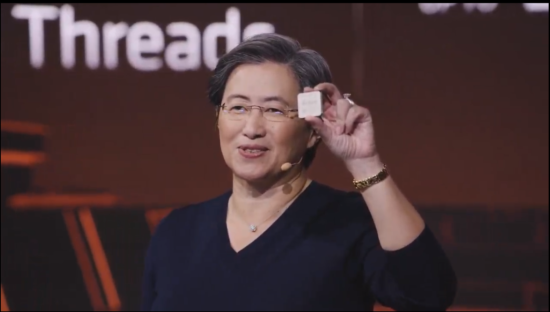
At today's AMD Gaming Event 2020, Team Red announced its next big thing in desktop CPUs—the Zen 3 powered Ryzen 5xxx series. The event was brief—only a half hour from start to finish—with AMD announcing record-breaking internal benchmark results.
AMD CEO Lisa Su, CTO Mark Papermaster, and Director of Technical Marketing Robert Hallock took turns extolling the new gear's features. The trio paints a picture of more unrelenting pressure being laid on competitor Intel. According to AMD testing, raw performance, power efficiency, IPC, and single-threaded performance all increased markedly compared to current leading desktop processors from both AMD and Intel.
-
Ryzen 9 5900X is a 12 core / 24 thread beast with a nearly 5GHz boost clock, but it still fits in a relatively frugal 105W TDP envelope.Jim Salter
-
The gaming uplift shown here is vs Ryzen 9 3900XT and might be a little misleading—AMD's fastest desktop CPU before now isn't the 3900XT, it's the 3950X.Jim Salter
-
Ryzen 9 5900X shows a smaller gaming uplift vs i9-10900K—but still an uplift.Jim Salter
-
November's 5900X is shown here putting the smack down on the prior single-threaded performance king, Intel's 19-10900K.Jim Salter
According to CTO Mark Papermaster, Zen 3—the architecture next month's Ryzen lineup is based on—has been in development for over five years. Zen 3 features a new unified 8-core complex that allows each core in the cluster direct access to L3 cache. Papermaster declared that the new architecture sees a 19-percent instructions per clock cycle (IPC) uplift when compared with Zen 2.
Marketing Director Robert Hallock took the more direct approach, using charts generated from in-company benchmarks to show the Ryzen 9 5900X demolishing both AMD and Intel CPUs. The charts show Ryzen 9 5900X, at 105W TDP, delivering an average 26-percent gaming uplift (as measured in frames per second) when compared to Ryzen 9 3900XT. Ryzen 9 5900X's gaming uplift compared to Intel's 125W i9-10900K was much smaller but still nearly unanimous—Battlefield V showed a minus-3-percent loss for the 5900X, with each of the other 10 games showing wins ranging from 1 percent to 21 percent.Finally, Hallock showed the 5900X taking the single-threaded performance crown away from Intel: the 5900X scores 631 on single-threaded Cinebench R20, a significant boost from the i9-10900K's score of 544.
For those who really care about thermals and power, we should also note that directly comparing the i9-10900K's 125W TDP to AMD's 105W TDPs can be pretty misleading. Although the difference between stated TDP is only 20 percent, we saw a 60-percent difference—336W vs 210W—in sustained, at-the-wall full-system power draw between an i9-10900K system and a Ryzen 9 3900XT system while running Cinebench R20 benchmarks. We also saw 30-percent lower desktop idle power draw, despite the Ryzen system having a discrete RTX 2060 GPU and the Intel system running on internal GPU only.
-
AMD saves the best for last—the 5900X beat the i9-10900K across the board, and the 16c/32t 5950X does the same to the 5900X.SKUs and prices
-
All announced Ryzen 5000 series desktop CPUs so far offer SMT, with parts in 6c/12t, 8c/16t, and 12c/24t. Ryzen 9 5950X (not pictured) is a 16c/32t part.SKUs and prices
-
The four SKUs announced will retail for $300, $450, $550, and $800.Jim Salter
After showing internal benchmarks of the 5900X taking every remaining crown from the Intel competition—although, as Hallock wryly noted, "we know you're going to wait for benchmarks"—Su took the stage again. She announced that the 5900X is not the highest-end part in the new lineup. The $800 Ryzen 9 5950X offers more cores and threads and a higher boost clock than the $550 5900X while maintaining the same 105W TDP.
-
The 5950X is compared directly to the 3950X—its introduction here explains why the 5900X was only compared to the 3900XT.Jim Salter
-
If anyone had any questions about whether Zen 3 beat the fastest Zen 2 CPUs, this slide answers them.Jim Salter
-
Su teased the Radeon RX6000 series, nicknamed "Big Navi," but with considerably less detail than she gave for Ryzen 5000.Jim Salter
The introduction of the 5950X late in the presentation finally explains why AMD was comparing the 5900X to the 3900XT, not to its fastest previous-generation desktop CPU—because that honor was reserved for the 5950X, which dominates the 3950X and Intel's i9-10900K alike.
The Ryzen 9 5900X didn't get to keep its single-threaded performance crown for long, either—AMD says the 5950X pulled a Cinebench R20 1T of 640, a little higher than the 5900X's already record-breaking 631.
Su also briefly teased a Radeon 6000 series GPU, affectionately nicknamed "Big Navi," along with short clips of 60+ FPS 4K triple-A gaming. The new GPU does not yet have a release date or official specifications, but we'll find out more on AMD's next gaming launch event on October 28.
AMD says that Ryzen 5000 CPUs are shipping to OEM partners today, and will be globally available starting November 5.
The Link LonkOctober 09, 2020 at 12:59AM
https://ift.tt/3dcLbWg
AMD’s new Zen 3 Ryzen desktop CPUs arrive November 5 - Ars Technica
https://ift.tt/2YXg8Ic
Intel

No comments:
Post a Comment